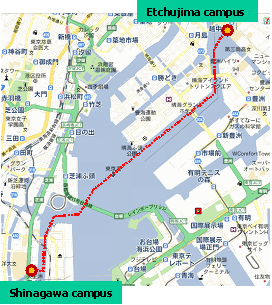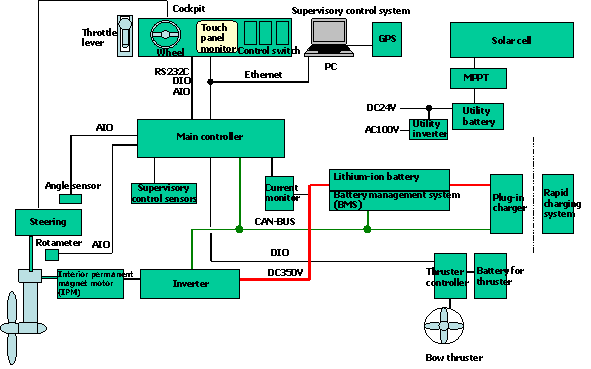"RAICHO-I" has some special and unique features that set it apart from existing electric or battery-powered boats. First, it utilizes a lithium-ion battery with a plug-in system or a rapid charging system. A dockside-mounted rapid charger can bring the boat's battery up to 80% of full charge within 30 minutes, which is a much shorter time than is possible using conventional charging systems. The boat can operate for 45 minutes in full speed service and berth for 30 minutes while recharging in a cyclic operation. The powerful lithium-ion battery gives the boat a running speed of around 10 knots (19 km/hr), enabling it to navigate not only in calm waters but also in open sea conditions where wind and waves prevent the use of conventional battery-powered craft.
The absence of exhaust gas emissions from the boat's electric motor gives this craft an environmental advantage over internal combustion engine-propelled boats, thereby contributing to a reduction in air and water pollution, especially in closed water areas. Because the electric motor does not emit carbon dioxide fumes it also contributes, in a modest way, to the slowing of global warming. A modal shift to the use of such battery-powered boats could lead to a significant reduction in environmental pollution. Another advantage is that the direct motor-driven propulsion system, which produces significantly less vibration and noise while the boat is running, also makes casting-off and mooring maneuvers much easier. While the estimated construction cost for this type of boat is about 1.5 times that of a combustion engine-driven craft with the same horsepower, the running cost for the battery-powered boat is only about half that of a conventional vessel.

March 2010:
Hull construction
Installed a rapid charger for marine use on the
campus
July 2010:
Navigation test
Sea route (Etchujima campus - Shinagawa campus)
Distance 7 km



- Technological tasks
- Best match optimization of power system (batteries and motors)
- Best match optimization of electric control system (battery control and maneuvering control)
- Best match optimization of navigation control system (battery residual power, power output, navigation schedule, position, sea state and weather conditions)
- Development of propulsion system
- Development of rapid-charging protocol for marine use
- Procedural and regulatory tasks
- Setting of regulations for battery-powered boats (in cooperation with the JCI and Fishery Agency)
- Proposal for ISO certification
- Installation of rapid charger for marine use
- Schedule
- The university and the consortium plan to construct twenty "RAICHO" class vessels in 2011.